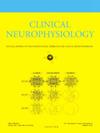Cerebral circuits involved in preferential hand posture representation for action
IF 3.7
3区 医学
Q1 CLINICAL NEUROLOGY
引用次数: 0
Abstract
Objective
The thumb-down/fingers-up (standard) posture was shown to be the configuration in which the hand is preferentially represented by the brain. This supra-modal representation results in improved sensorimotor performances. This study aims at identifying the cortical circuit responsible for this advantage.
Methods
Different TMS coil orientations (antero-posterior, latero-medial, postero-anterior) − activating different cortical circuits- have been used to test cortico-spinal and cortico-cortical connections in different postures. Additionally, pair-pulse TMS protocols were used to explore inhibitory and facilitatory mechanisms within the primary motor cortex (M1) that might contribute to the observed postural advantage.
Results
A significant corticospinal excitability difference in nMEPs between standard and inverse posture was observed with antero-posterior TMS (p = 0.003), activating cortico-cortical connections from premotor cortex (PM) and with postero-anterior TMS (p = 0.042), favoring local cortical connections. Latero-medial stimulation, activating direct corticospinal connections, did not show a preference. A MEPs analysis further revealed a significant effect exclusively for antero-posterior stimulation (p < 0.003). Intracortical facilitation and inhibition were unaffected by hand postures.
Conclusions
The postural advantage of the thumb-down/fingers-up hand configuration is associated with a neural circuit involving PM cortex projecting to M1, activated by antero-posterior and postero-anterior TMS.
Significance
The corticospinal evoked activity to different TMS protocols gave cues on the neural basis of body representation and favored posture.
大脑回路涉及动作的优先手部姿势表征
目的研究拇指向下/手指向上(标准)姿势是大脑优先表征手的构型。这种超模态表征导致感觉运动表现的改善。这项研究旨在确定负责这种优势的皮层回路。方法采用不同的经颅磁刺激线圈取向(前后、后内侧、后前)-激活不同的皮层回路-测试不同姿势下皮质-脊髓和皮质-皮层连接。此外,对脉冲TMS方案被用于探索初级运动皮层(M1)的抑制和促进机制,这可能有助于观察到的姿势优势。结果前后经颅磁刺激可激活运动前皮层(PM)和前后经颅磁刺激可激活局部皮层连接(p = 0.042),标准体位和倒立体位nmep的皮质-脊髓兴奋性差异显著(p = 0.003)。激活皮质-脊髓直接连接的后内侧刺激没有表现出偏好。一项MEPs分析进一步显示,只有前后刺激才有显著效果(p <;0.003)。皮质内促进和抑制不受手势的影响。结论拇指朝下/手指朝上的姿势优势与PM皮层投射到M1的神经回路有关,该神经回路由前后和后前经颅磁刺激激活。意义不同经颅磁刺激方案的皮质脊髓诱发活动提示了身体表征和偏好姿势的神经基础。
本文章由计算机程序翻译,如有差异,请以英文原文为准。
求助全文
约1分钟内获得全文
求助全文
来源期刊

Clinical Neurophysiology
医学-临床神经学
CiteScore
8.70
自引率
6.40%
发文量
932
审稿时长
59 days
期刊介绍:
As of January 1999, The journal Electroencephalography and Clinical Neurophysiology, and its two sections Electromyography and Motor Control and Evoked Potentials have amalgamated to become this journal - Clinical Neurophysiology.
Clinical Neurophysiology is the official journal of the International Federation of Clinical Neurophysiology, the Brazilian Society of Clinical Neurophysiology, the Czech Society of Clinical Neurophysiology, the Italian Clinical Neurophysiology Society and the International Society of Intraoperative Neurophysiology.The journal is dedicated to fostering research and disseminating information on all aspects of both normal and abnormal functioning of the nervous system. The key aim of the publication is to disseminate scholarly reports on the pathophysiology underlying diseases of the central and peripheral nervous system of human patients. Clinical trials that use neurophysiological measures to document change are encouraged, as are manuscripts reporting data on integrated neuroimaging of central nervous function including, but not limited to, functional MRI, MEG, EEG, PET and other neuroimaging modalities.
 求助内容:
求助内容: 应助结果提醒方式:
应助结果提醒方式:


